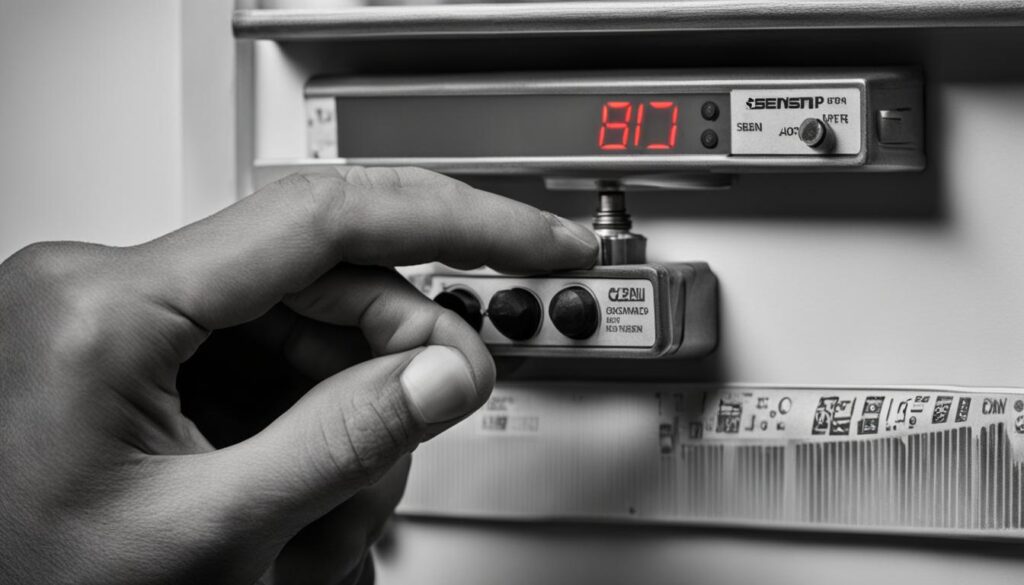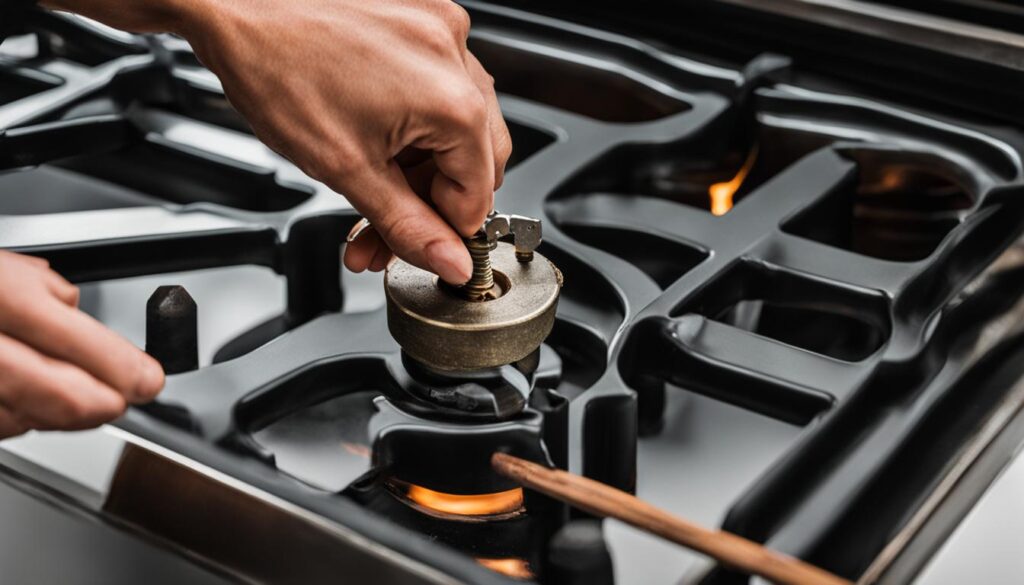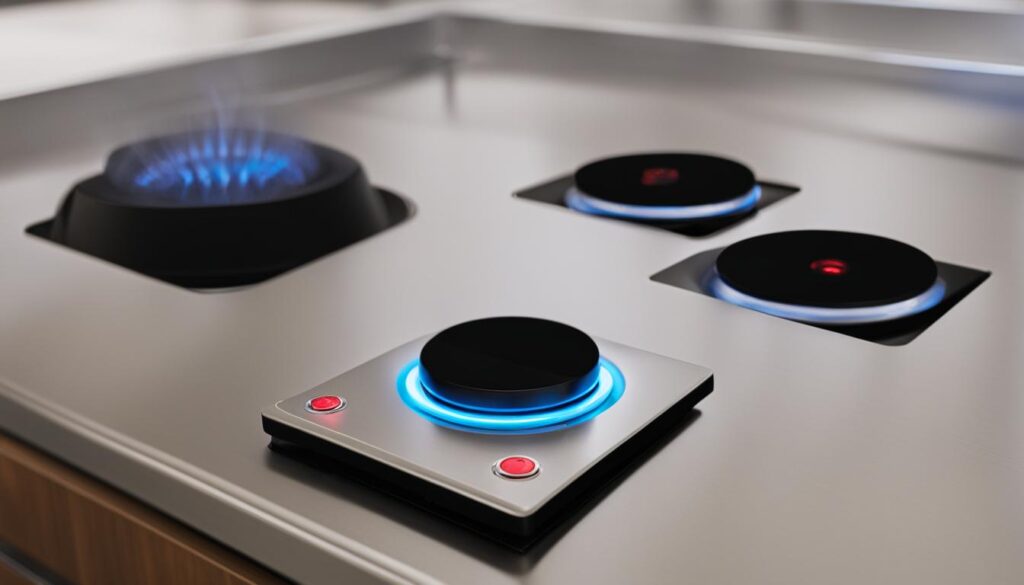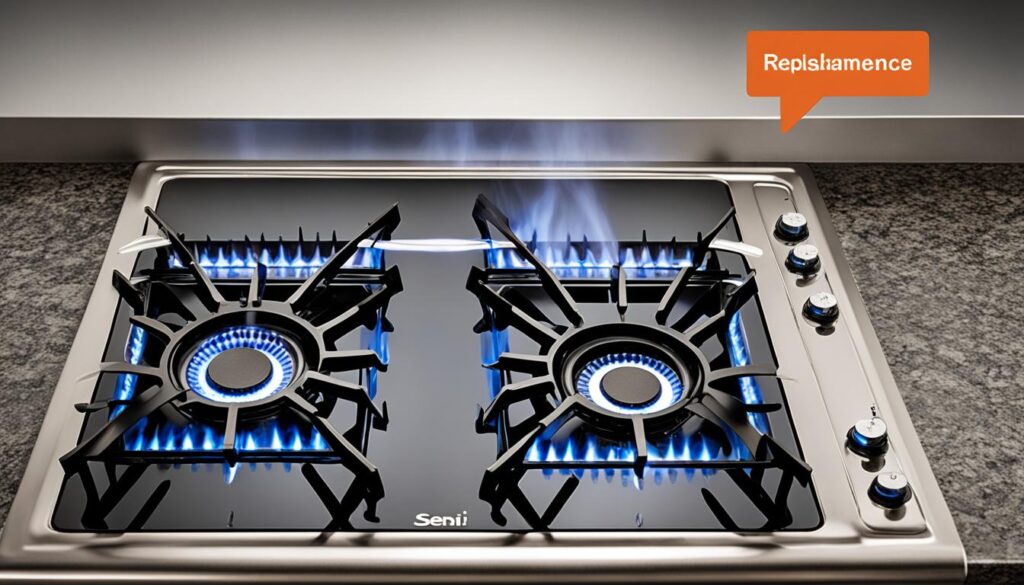
Sensi-Temp technology is a safety feature found in electric ranges with coil burners or elements. While it aims to reduce the risk of fires by limiting the temperature of cookware, some users find it disruptive to their cooking experience. If you’re one of them, don’t worry! There are ways to disable Sensi-Temp technology and regain control over your stove’s temperature regulation.
In this article, we will explore the steps to turn off Sensi-Temp technology and provide you with alternative solutions. Whether you prefer to replace the burners or disable the sensor, we’ve got you covered. Say goodbye to the frustration and inconvenience, and hello to a cooking experience that suits your needs.
Key Takeaways:
- Disabling Sensi-Temp technology allows you to regain control over your stove’s temperature regulation.
- Replacing the burners with traditional ones or disabling the sensor are both viable solutions.
- Contrary to what GE initially claims, it is possible to disable the safety feature by unplugging the burner and hotwiring the wires together.
- Choosing compatible replacement burners, such as the Kitchen Basics coil burner set, is recommended for optimal performance.
- Consider the potential consequences, such as receptacle damage, when deciding whether to disable Sensi-Temp or replace the burners.
What is Sensi-Temp Technology
Sensi-Temp technology is a safety feature required by UL regulation starting in 2018. It is specifically designed for electric ranges with coil burners or elements to reduce the risk of cooktop fires caused by oil and grease. The technology incorporates temperature limiting capabilities to ensure that the cookware does not reach hazardous temperatures, thus minimizing the potential for fires.
The main function of Sensi-Temp technology is to monitor and control the temperature of the coil burners or elements. It achieves this by utilizing a sensor that detects the temperature of the cookware during the cooking process. When the temperature reaches a dangerous level, the technology automatically shuts off the coil until the temperature drops to a safe range. This temperature regulation helps reduce the risk of fires and promotes kitchen safety.
Although Sensi-Temp technology adheres to UL regulations and provides safety benefits, some users find it inconvenient and disruptive to their cooking experience. The automatic shut-off feature can occasionally interrupt the cooking process and prolong cooking times. As a result, some individuals prefer to disable or bypass Sensi-Temp technology to regain more control over their cooking process.
Check out the image below to get an idea of how Sensi-Temp technology works:
Overall, Sensi-Temp technology plays a crucial role in reducing the risk of fires by limiting the temperature of coil burners or elements. It offers an added layer of safety and peace of mind in the kitchen. However, it is understandable that some users may prefer to explore alternative options to accommodate their specific cooking preferences and needs.
How to Bypass Sensi-Temp Technology
If you want to bypass Sensi-Temp technology, there are two options you can consider. The first option is to replace the burners with traditional ones that do not have the sensor. The second option is to disable the sensor itself. Contrary to what GE initially claims, it is possible to disable the safety feature by unplugging the burner from the receptacle and hotwiring the wires together. This effectively bypasses the sensor and allows the burners to operate without the temperature regulation.
Replacing Burners
If you choose to replace the burners, it’s important to ensure compatibility with your electric range. Look for traditional burners that are specifically designed for your stove model. Pay attention to factors like size, wattage, and the number of turns. By replacing the Sensi-Temp burners, you can restore your stove to its original functionality without the temperature limiting capabilities.
Disabling the Sensor
To disable the sensor, you need to access the burner and hotwire the wires together. Follow these steps:
- Turn off the power supply to the stove.
- Remove the burners by lifting them out of the receptacles.
- Locate the sensor underneath the burner.
- Unplug the burner from the receptacle.
- Using a pair of needle-nose pliers, hotwire the two wires connected to the sensor. Connect them firmly together by twisting the exposed ends.
- Once the wires are securely connected, plug the burner back into the receptacle.
By following these steps, you can effectively bypass the Sensi-Temp sensor and restore full control over the temperature regulation of your stove.
| Benefits of Bypassing Sensi-Temp Technology |
|---|
| Regain control over temperature regulation. |
| Enable high heat settings for specific cooking techniques. |
| Restore traditional stove functionality. |
Remember, bypassing the Sensi-Temp technology may void any warranties or safety certifications associated with the stove. Proceed with caution and consider consulting a professional if you are unsure about performing the necessary modifications.

How to Replace Sensi-Temp Coil Burners
When it comes to replacing Sensi-Temp coil burners, it’s essential to choose compatible replacements that match the number of turns, wattage, and size of the original burners. One highly recommended option is the Kitchen Basics coil burner set available on Amazon.
The Kitchen Basics coil burners are designed to be compatible with various electric ranges, including popular brands like GE and Hotpoint. They are UL/CSA approved, ensuring their safety and compliance with industry standards. With the same wattage as the original burners, you can trust that they will deliver the performance you need for your cooking tasks.
What sets the Kitchen Basics burners apart is the extra turn they offer. This additional feature provides improved heat distribution for your cookware, resulting in more even cooking and better culinary results.
Overall, replacing Sensi-Temp coil burners with the Kitchen Basics coil burner set from Amazon is a reliable and convenient solution. With their compatibility, UL/CSA approval, and enhanced heat distribution, you can enjoy your cooking experience without worrying about compromised performance.

Note: The image above demonstrates the components of a coil burner and is for illustrative purposes only.
How to Disable Sensi-Temp Burner Sensors
If you want to disable the Sensi-Temp burner sensors, you can bypass the sensor by hotwiring the wires together. Just follow these simple steps:
- Start by removing the metal cap of the burner. It is usually held in place by small brackets.
- Once the cap is removed, you will see two wires connected to prongs on the underside of the sensor.
- Join these two wires together using needle-nose pliers, or by pushing the prongs down until they touch.
- For a more secure connection, you can use high-temperature ceramic or porcelain wire nuts to join the wires together.
- After connecting the wires, replace the metal cap and bend the brackets back to their original position.
By following these steps, you effectively bypass the sensor and disable the Sensi-Temp burner sensors. This allows the burners to operate without the temperature regulation imposed by the technology.
Please note that disabling the Sensi-Temp burner sensors may void any warranty or UL/CSA certifications on your stove. Proceed with caution and consider the potential risks and consequences before making any modifications.
Important Safety Precautions:
Always ensure that the stove is unplugged and completely cool before attempting any modifications. Work in a well-ventilated area and wear appropriate safety gear.
As a visual aid, here’s an image showing the process of disabling the Sensi-Temp burner sensors:

Remember to exercise caution and consult a professional if you are unsure about any steps or if you have any concerns about performing modifications to your stove.
Should You Disable Sensi-Temp or Replace the Burners
When it comes to deciding whether to disable Sensi-Temp or replace the burners in your electric range, there are a few important factors to consider.
Consider Burner Elements and Receptacles
Some users have reported that disabling the sensor can lead to burner elements failing over time or receptacles burning out due to the increased heat or current draw. This is because disabling the temperature regulation removes the safety measures put in place to protect the burners and receptacles from excessive heat.
High Heat Settings and Stove Longevity
Additionally, using the stove on high heat settings for prolonged periods without the temperature regulation can also lead to faster wear and tear on the burners and other components of the stove. This can potentially shorten the overall longevity of your stove.
Explore Compatible Replacement Options
If you decide to replace the burners instead of disabling Sensi-Temp, it is essential to choose compatible replacements that provide the desired level of heat distribution and performance. The Kitchen Basics burners, for example, are a popular choice as they offer compatibility with various brands, including GE and Hotpoint. These burners are designed to provide a lower wattage, which can help prolong the longevity of the stove while still delivering efficient cooking performance.
Consider Compatibility and Convenience
The compatibility of replacement burners is an important aspect to consider. Choosing burners that are specifically designed to fit your electric range helps ensure that they will fit properly and function optimally. The Kitchen Basics burners mentioned earlier, for example, are UL/CSA approved and known for their compatibility with multiple brands, making them a convenient solution for stove owners.
| Kitchen Basics Burners | Replacement Burners | |
|---|---|---|
| Compatibility | Compatible with multiple brands, including GE and Hotpoint | Varies depending on the brand and model |
| Wattage | Lower wattage for prolonged stove longevity | Varies depending on the brand and model |
| Heat Distribution | Better heat distribution due to the extra turn | Varies depending on the brand and model |
| UL/CSA Approved | Yes | Varies depending on the brand and model |
By considering these factors and weighing the pros and cons of disabling Sensi-Temp or replacing the burners, you can make an informed decision that aligns with your cooking needs and preferences. Whether you prioritize convenience or stove longevity, there are options available to help you regain control over your cooking experience.

Closing Thoughts
Sensi-Temp stoves have garnered mixed reviews, with some users considering the replacement of their new stoves with traditional models lacking this technology. Government regulations necessitating Sensi-Temp have faced criticism, as many individuals find it disruptive to their cooking process. However, by opting for modified replacement coil burners or disabling the sensor, users can restore control over their cooking experience and revive the traditional stove performance they desire.
It is understandable that some people prefer the familiarity of traditional stoves without the limitations imposed by Sensi-Temp technology. This sentiment has driven many to explore alternative options, such as replacing their stoves or disabling this feature altogether. While Sensi-Temp was implemented with safety in mind, it has its drawbacks, causing frustration for those seeking greater flexibility in their cooking methods.
To regain control over temperature regulation and restore the performance of a traditional stove, two potential solutions exist. The first is to replace the Sensi-Temp coil burners with modified replacements that do not feature temperature-limiting capabilities. These modified burners can offer the same power and heat distribution as traditional burners, delivering a comparable cooking experience.
The second option involves disabling the sensor responsible for regulating temperature. Contrary to initial assertions by the manufacturer, it is possible to bypass the sensor and restore full control over the stove’s performance. By hotwiring the wires connected to the sensor, users can effectively deactivate the Sensi-Temp feature, allowing the burners to operate without any imposed limitations.
Ultimately, the decision to disable Sensi-Temp or replace the burners depends on individual preferences and priorities. Disabling the sensor offers a direct solution, but it is essential to consider potential consequences such as increased heat or current draw, which may lead to burner elements failing or receptacles burning out over time.
In contrast, opting for modified replacement coil burners can provide a more reliable, long-term solution. These burners have been specially designed to ensure compatibility and optimal performance in electric ranges. Additionally, they often come with UL/CSA (Underwriters Laboratories/Canadian Standards Association) approval, further guaranteeing their safety and reliability.
In summary, Sensi-Temp stoves have sparked a debate among users, with government regulations introducing a technology that not everyone finds essential or beneficial. By replacing the burners with modified alternatives or disabling the sensor, individuals can regain control over their cooking experience and enjoy the performance characteristics of a traditional stove without limitations. The choice ultimately rests with the user, considering their specific needs and preferences.
Is Turning Off Sensi-Temp Technology a Way to Protect Your Information When Using Wireless Technology?
Turning off Sensi-Temp Technology may not be an effective method for protecting wireless technology information. It’s best to utilize encryption and strong passwords to safeguard sensitive data. Additionally, using a virtual private network (VPN) can add an extra layer of security when using wireless technology.
Conclusion
Disabling Sensi-Temp technology or replacing the burners are two viable options for users who find the feature disruptive to their cooking experience. By following the steps to bypass the sensor or replacing the burners with compatible ones, users can regain control over the temperature regulation of their stoves and restore the performance to that of a traditional stove.
However, it is important to consider the potential consequences, such as receptacle damage, when making a decision. Disabling the sensor may increase the risk of burner element failure or receptacle burning out due to higher heat or current draw. It is crucial to weigh the benefits and drawbacks of each option before making a choice.
Ultimately, finding the right solution for your cooking needs is crucial to ensure a satisfactory cooking experience. Whether you choose to disable Sensi-Temp or replace the burners, it is important to prioritize safety and ensure compatibility with your stove model. Restoring the stove’s performance to that of a traditional stove will allow you to regain control and fully enjoy your cooking endeavors.








